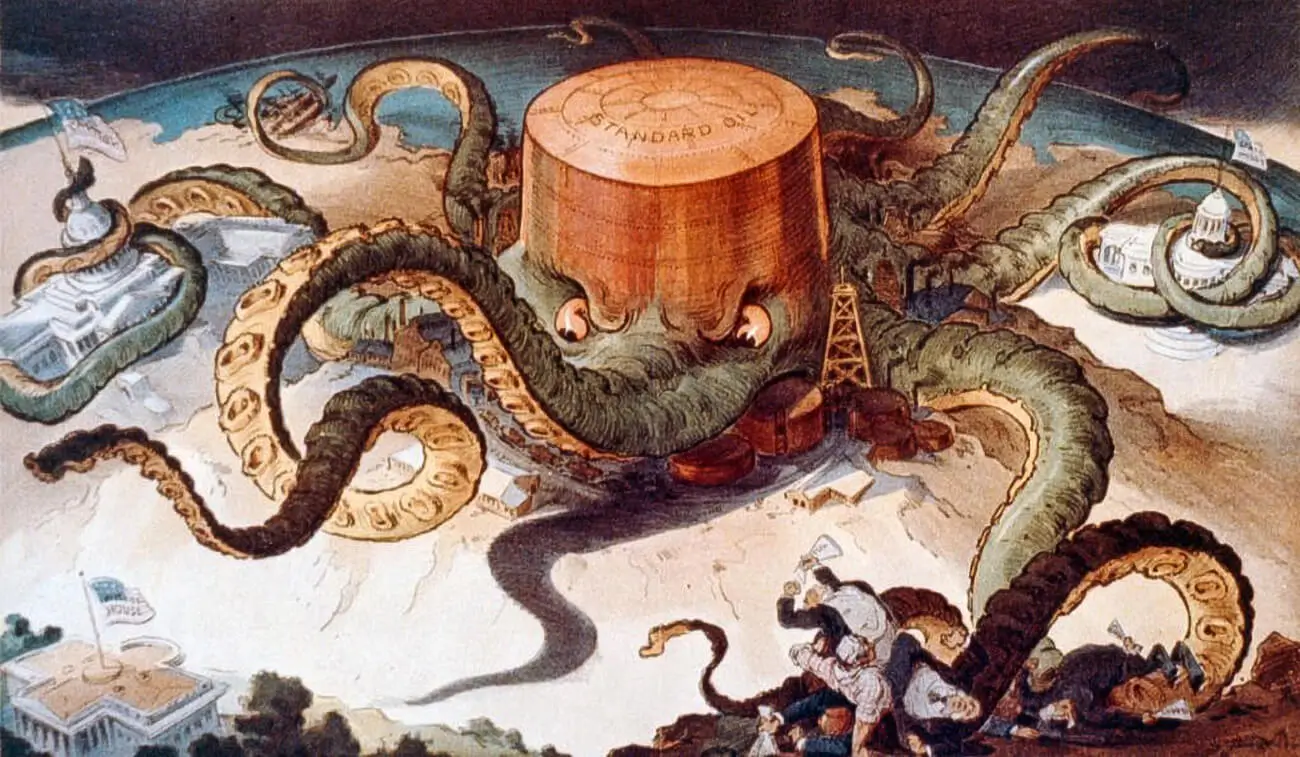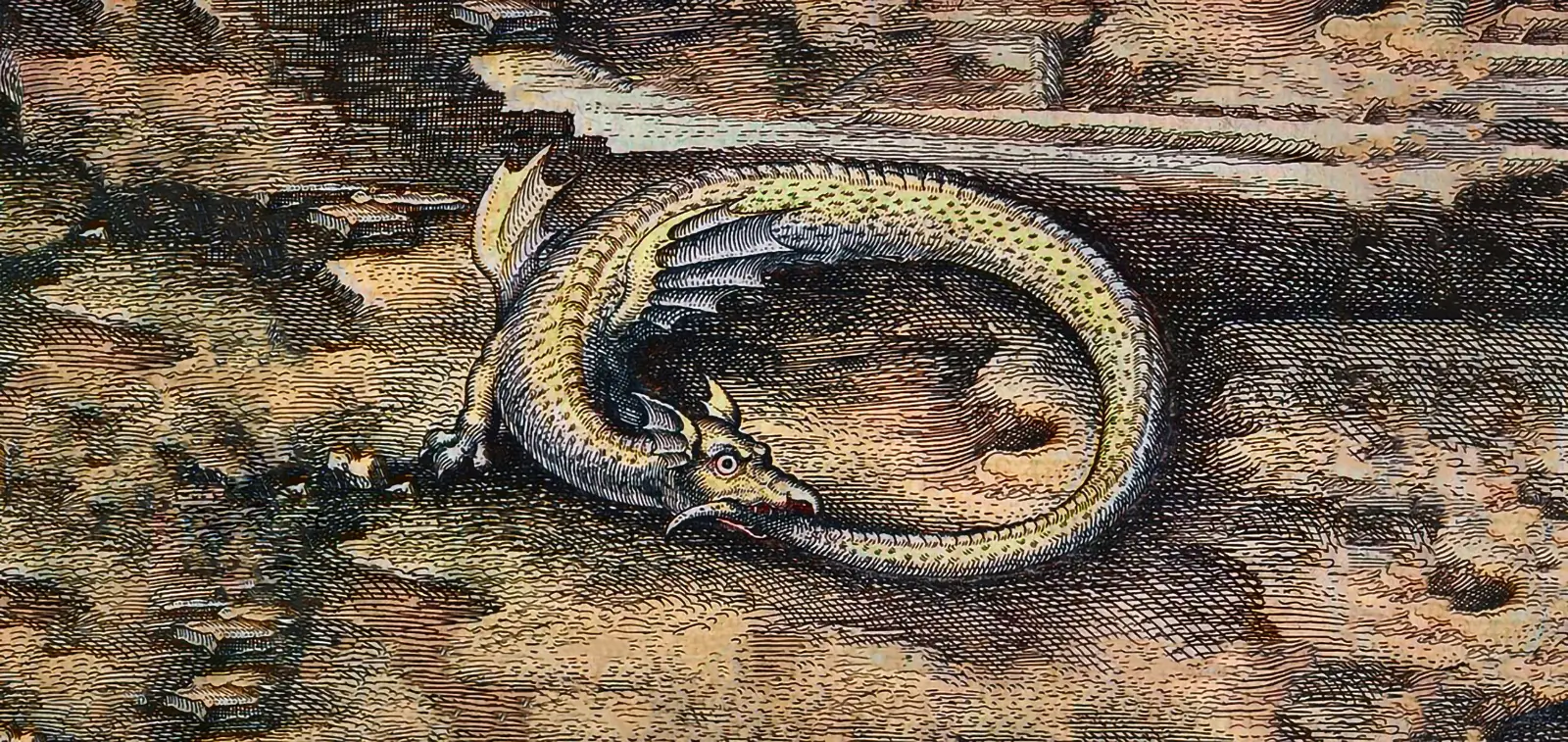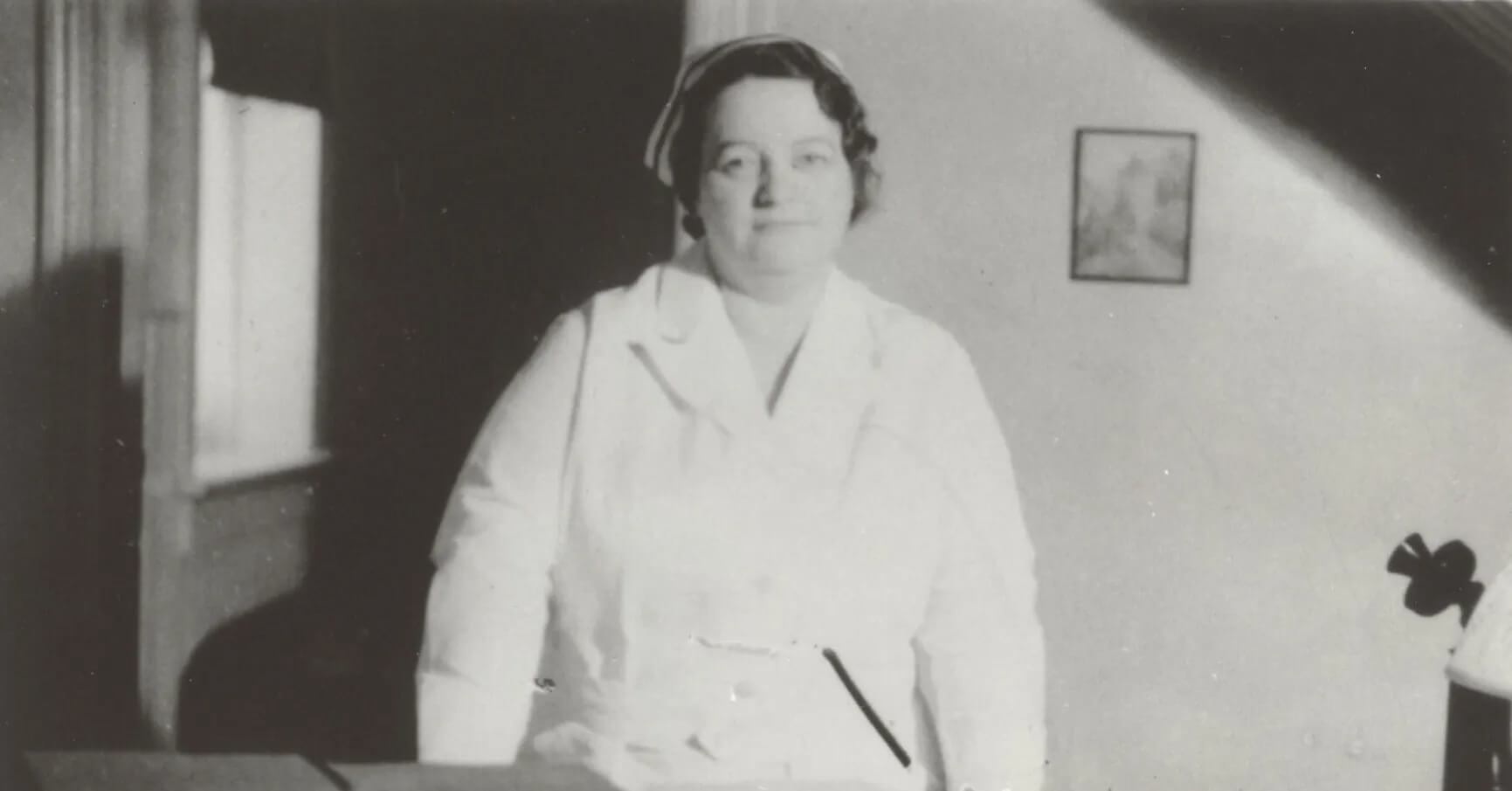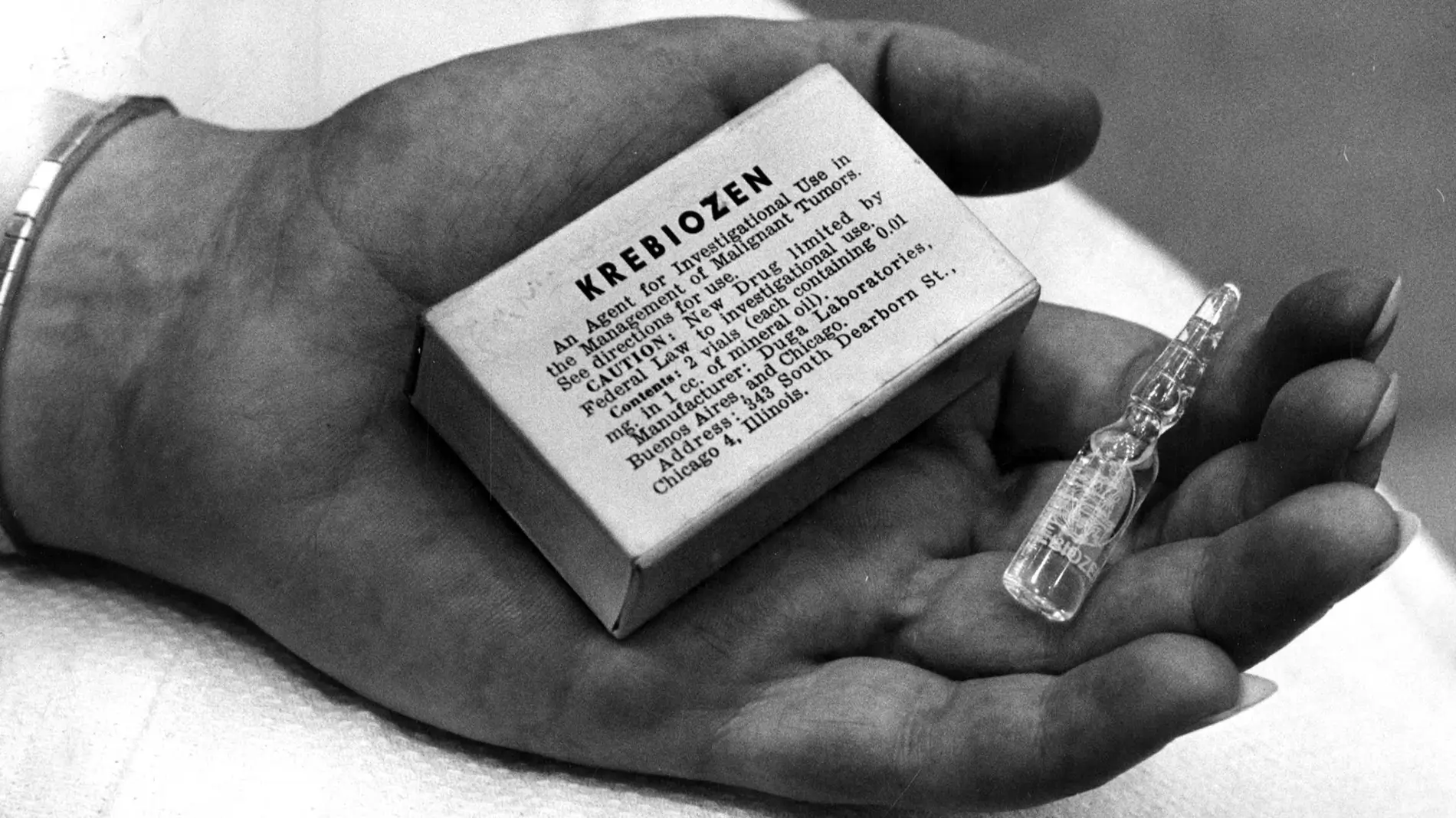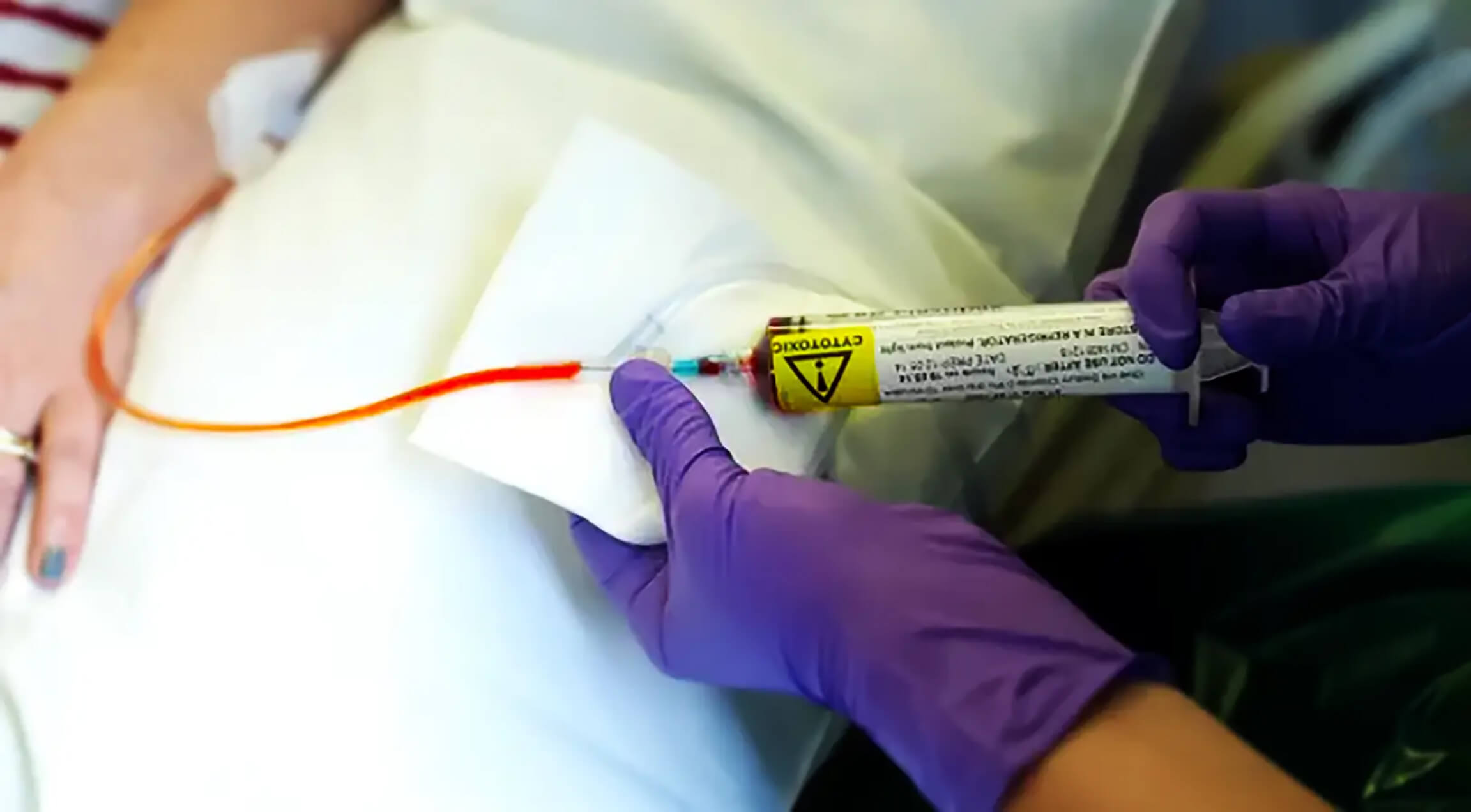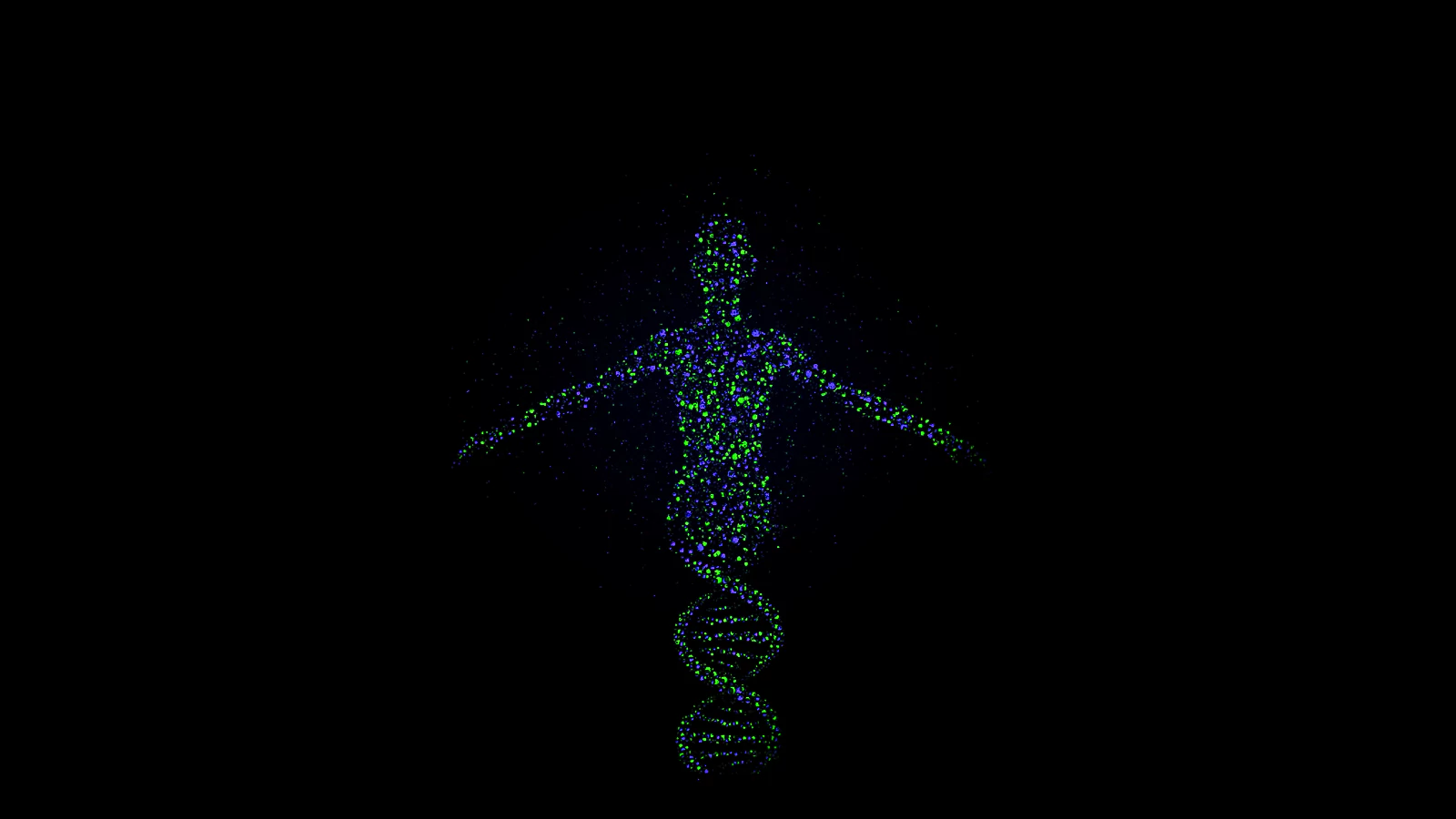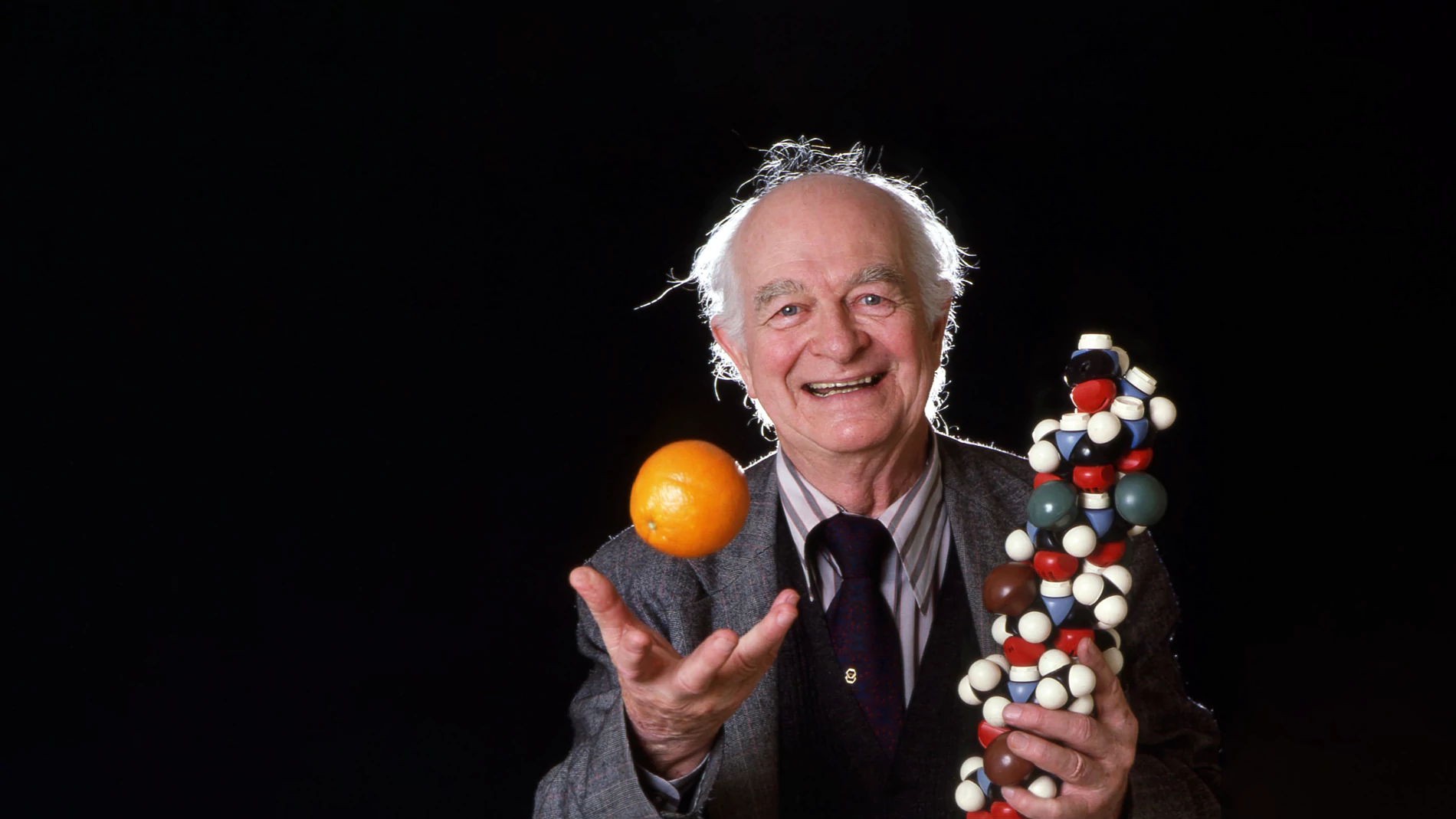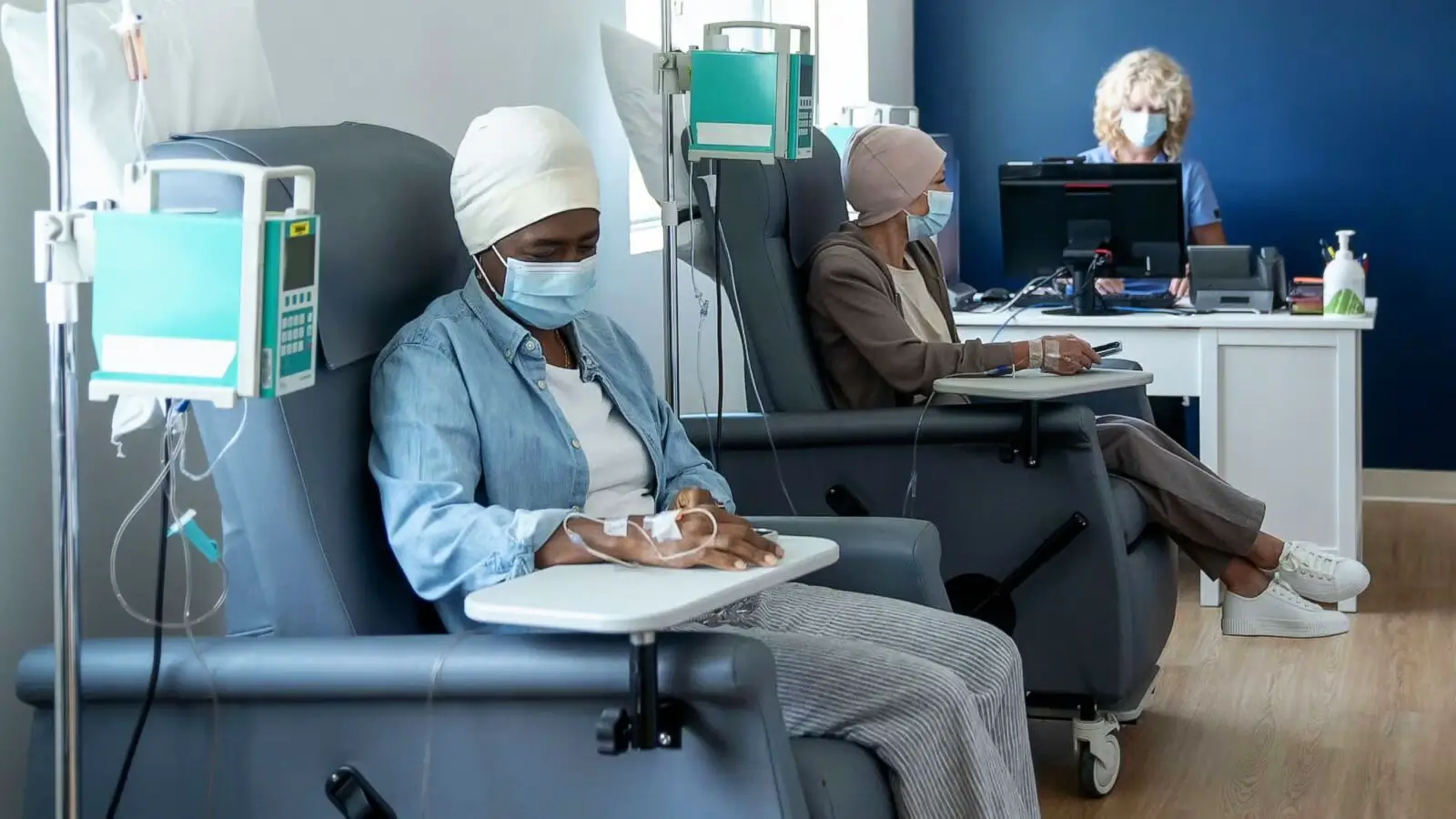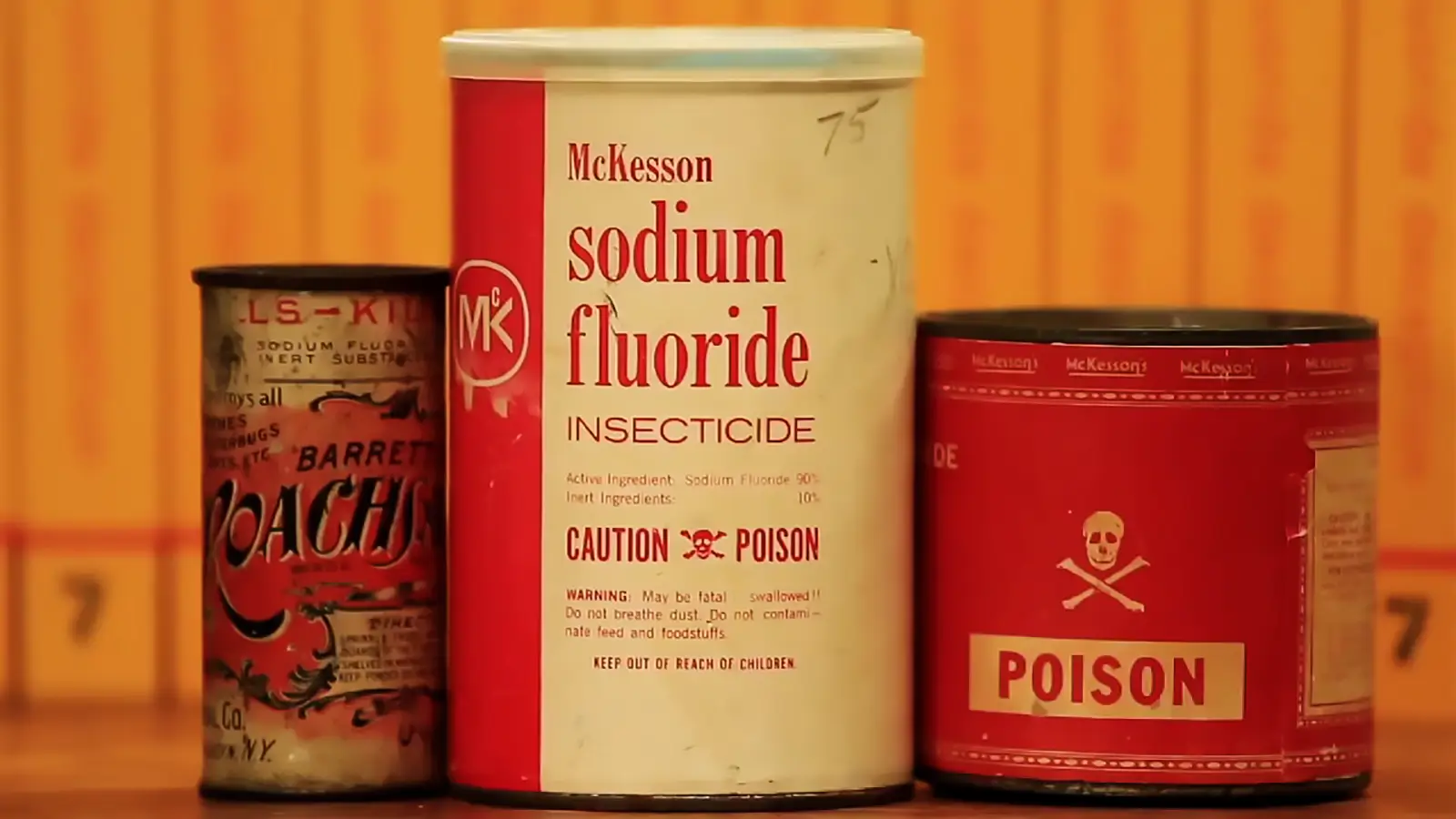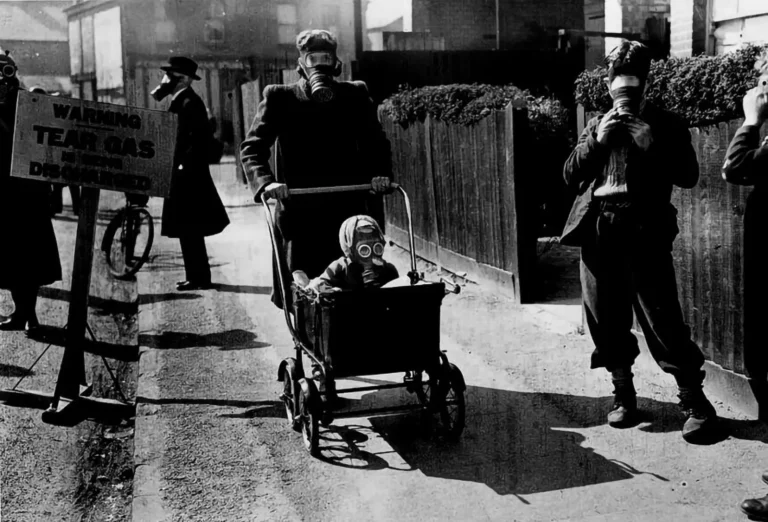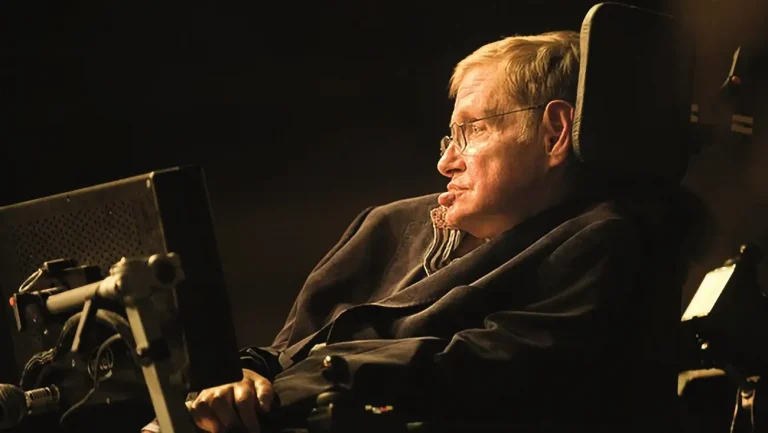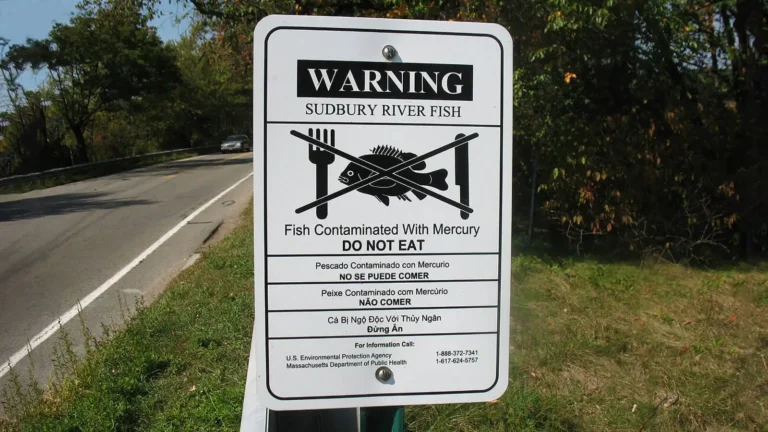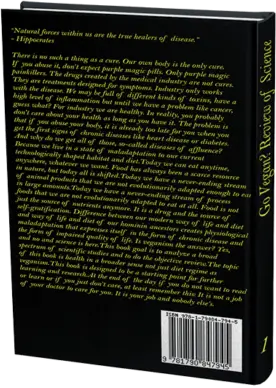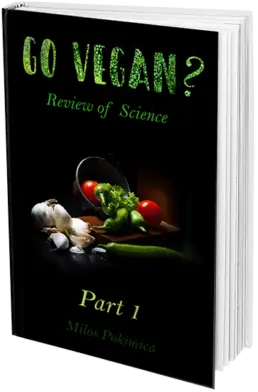Cancer, The Forbidden Cures-Rife machine, Historical review
The recovery rate for patients that have non-treatable cancer and were declared terminally ill by utilizing Rife Machine resonant technology was 100%.
Milos Pokimica
Written By: Milos Pokimica
Medically Reviewed by: Dr. Xiùying Wáng, M.D.
Updated June 9, 2023Royal Raymond Rife developed technology that is still commonly used today in the fields of optics, microscopy, electronics, radiochemistry, biochemistry, ballistics, and aviation and particularly in imaging and medical microscopy. Royal Raymond Rife also developed technology (Rife Machine) that was surprised that you probably don’t know about. In life, he was awarded 14 different rewards. Rife attended Heidelberg University in Germany. He received an honorary Doctor of Parasitology degree there. Rife also received an honorary Doctor of Science degree from the University of Southern California in 1936.
Rifle’s inventions include the heterodyning ultraviolet microscope, a micro dissector, and a micromanipulator.
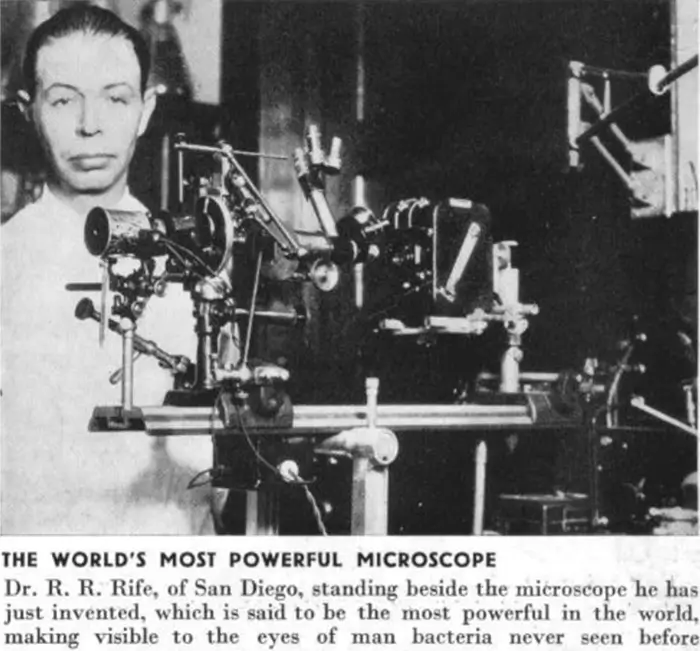
He was not just some quack like most of the “educated” people in the field of medicine will like you to believe. His original business while still attending the university was with the firm of Carl Zeiss, at their New York City offices, and later at their offices in Germany where he worked directly with Carl Zeiss, Hans Luckel, and other scientists in the research, design, and production of excellent microscopes. He spent five years working with that group while he was attending the University of Heidelberg. It is stated that Rife worked with the United States Navy before and during World War One and that he was commissioned as a Lt. Commander USNR. During the years just before the great depression, Dr. Rife worked for both the United States Government and the Carl Zeiss Optics firm. At one period, his monetary base dissolved and he took a job as a chauffeur for multimillionaire Henry Timkin. Dr. Rife’s association with Henry Timkin served well for both of them. Timkin fabricated roller bearings. Some of the bearings were crumbling down due to imperfections in the steel used to create the bearings. Rife designed and built an X-ray device that monitored every bearing getting out and discarded every faulty one before it could be sent out as a finished product. He saved the company millions. Timkin was so satisfied that he established a monthly lifetime payment to Rife for providing the specialized X-ray machine for his production environment.
Henry Timkin and his partner, Bridges remained so fascinated with Dr. Rife and his work that they set up a fund to finance a wholly equipped laboratory at Point Loma, California, and to carry the expenses of a research program in the laboratory that was created. In the laboratory mentioned above, he performed most of his experiments. At one point, Rife had as many as twelve laboratory assistants working for him. In 1916 most powerful microscopes could reach a magnification of 2500 diameters. With this instrument, a scientist could see parasites, mold, and many bacteria, but no one had seen a virus.
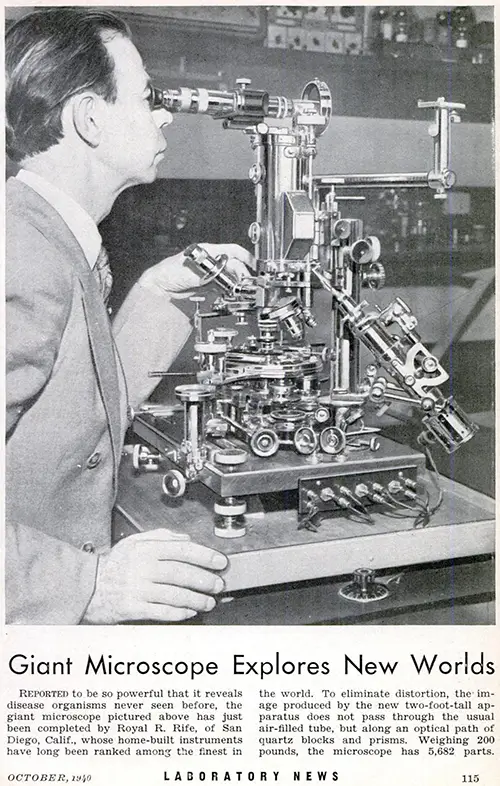
Rife built a magnifying instrument that worked on a different principle than the existing microscopes of his day. The first microscope that enabled him to see a virus was built in 1920. Rife was the creator of the Universal Microscope which he introduced to the world in 1933 as the world’s most powerful microscope. One of the various attractive characteristics of this microscope is that, in contrast to the Electron Microscope, the Universal Microscope does not kill the specimens under observation and allows observation of actual living specimens in all conditions, indicating it does not rely on fixing or staining to render visibility or definition. With his microscope, Rife became the first human being actually to see a live virus, and until quite recently, the Universal Microscope was the only one who was able to observe living viruses. Modern electron microscopes instantly kill everything. The rife microscope can see the bustling activity of living viruses as they change form to accommodate changes in an environment, replicate rapidly in response to carcinogens, and transform normal cells into tumor cells. Rife managed this by utilizing various forms of lighting to bring the virus within visibility. He first used the technique of using light to stain the subjects because he understood that the particles of the chemical stains were much too large to enter into the structures he attempted to visualize.
Furthermore, stains used in microscopy are often lethal to the specimens. One factor allowing these original images was Rife’s use of a tool called a Risley counter-rotating prism. The refracted and polarized ray will normally hidden organism that is invisible and would become visible in color peculiar to their structure or chemical make-up. All optical elements were made of block quartz, which permits the passage of ultraviolet rays. By this means Rife found out that different bacteria and viruses glow at different frequencies. If you do not understand the science behind you can read this article Cancer, The Forbidden Cures-Rife Machine, Scientific Review. This proved that organisms could be classified by their index of refraction or in other words their resonance frequency. In other words, he found out that they vibrate under different frequencies. Rife slowly classified the unique spectroscopic signature of each microbe, using a slit spectroscope attachment. Then, he gradually twisted prisms to focus light of an individual wavelength upon the microorganism he was examining. Then it resonated with the spectroscopic signature frequency of the microbe based on the now-established fact that every molecule oscillates at its distinct frequency.
Utilizing a resonant wavelength micro-organisms that cannot be seen in white light suddenly become visible as a flash of light when they are exposed to the color frequency that resonates with their distinct spectroscopic signature. Rife was capable of seeing those otherwise invisible organisms and watch them how they behave. He could view organisms that no one else could see with ordinary microscopes.
Rife was so far ahead of his co-workers in the 1930s that it was hard for them to understand what he was actually doing without traveling directly to San Diego to Rife’s laboratory to look for themselves through his Virus Microscope. And several did precisely that. One was Virginia Livingston. She ultimately went from New Jersey to Rife’s Point Loma (San Diego) neighborhood to live and became a regular visitor to his lab. Virginia Livingston is now given credit for identifying the organism which causes human cancer, based on research papers she published in 1948. The real truth is that Rife had identified the human cancer virus in 1920. He called the cancer virus ‘Cryptocides primordiales.’ Virginia Livingston renamed it to ‘Progenitor Cryptocides.’ Royal Rife was never even stated in her papers.
In fact, Rife rarely got credit for his monumental discoveries. He was a modest, humble scientist, committed to expanding his discoveries rather than to ambition, fame, and glory. He started research work on tuberculosis in 1920. In a short time, it became clear to Rife there was more involved in this disease than a bacterium. This encouraged him to develop “virus” microscopes, of which two preceded the Universal. Rife was the first scientist to isolate and photographed active tuberculosis as well as many other viruses. Rife also worked in isolating a virus specific to cancer, seeing it gave off a unique purple-red emanation. There was no success until Rife by mistake left a tube in the light of an ionizing lamp. He noticed the tube became clouded, registering activity.
Their work leads to the first successful culturing of the virus outside a living host. Rife extracted the cancer virus from a ” human breast mass.” He filtered, cultured, and re-cultured these over ten times over a two hundred and forty-hour period. They inserted the last-generation culture into the live rat. The rat would inevitably develop cancer. Rife would then extract cancer, extract the virus, and repeat the process. He did this procedure over four hundred times.
He established categorically that the virus-induced cancerous tumors in every instance. After Dr. Rife know how to see a virus, the next logical step became to devise a method to kill the virus or microbe without damage to the host. Since the days of Nikola Tesla and his work, men of science had known of the connection of frequencies with the operation of the human body, so Rife turned to electromagnetic frequencies because he could detect bacteria and viruses to unique frequencies and then expose them and watch the effects. He found that each microorganism had a distinct frequency to which it resonates and was defenseless. Rife termed this the “mortal oscillatory rate.”
Over and over again he would observe the virus absorbing energy and dying when a certain frequency was applied. Sometimes they even exploded. He created charts revealing which frequency settings would kill which microbe or virus. If he did not invent his microscope, there would have been no treatment based on resonance. Numerous reports and news stories emerged concerning these extraordinary achievements. His work became known to many physicians in the Southern California area. Some of them even came from all over the United States to observe what he was doing and verify his results. In November 1931, Dr. Milbank Johnson called forty-four Los Angeles area doctors to his home in Pasadena, California to acknowledge Rife for the work he was performing. Dr. Royal Rife was acknowledged as the man who ended all diseases that ever existed. Well, at least the ones that are infectious and can be bombarded with resonance. The banquet was even called “The End of All Disease.”
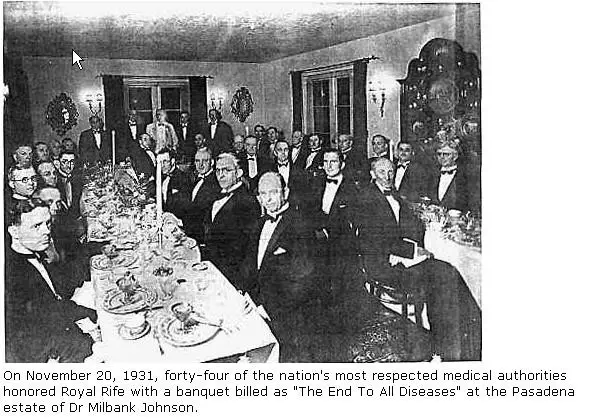
In 1934, a group of physicians led by Dr. Milbank Johnson of Pasadena, California, in an experiment that was sponsored by the University of California brought sixteen terminally ill patients from a hospital in San Diego. They were radiated with the frequencies recommended by Dr. Royal Rife for ninety days to activate resonance and destroy cancer.
It was the first time in history that terminally ill cancer patients were healed completely.
Read this sentence again.
It was the first time in history that terminally ill cancer patients were healed completely.
Fourteen of the patients became completely free of any cancer at that time. The therapy was then adjusted, meaning the resonant frequency and the remaining two patients also responded.
The recovery rate for patients that have non-treatable cancer and were declared terminally ill by the accepted medical industry by utilizing Rife’s resonant technology was 100%.
Read this sentence again.
The recovery rate for patients that have non-treatable cancer and were declared terminally ill by the accepted medical industry by utilizing Rife’s resonant technology was 100%.
Through 1939 Dr. Rife was formally summoned to address the Royal Society of Medicine in London, England, which had verified his findings. He further received invitations to lecture in France and Germany. Dr. R. Seidel described and formally published the Rife Ray Tube system therapy for the treatment of cancer in the journal of the Franklin Institute in February 1944. Dr. Rife’s treatments of the virus and bacterial infections and his microscopes were described and praised by the Smithsonian Institute in an article published in the Institute publication during 1944. A report from the Smithsonian Institution confirms Rife’s work. Titled “The New Microscope” by Dr. R.E. Seidel (report #3781) it states:
“Under the Universal Microscope disease organisms such as those of cancer … and another disease may be observed to succumb when exposed to certain lethal frequencies…”
It took a Rife long time, years of his life, working 48 hours at a time until he detected the frequencies which explicitly destroyed herpes, polio, spinal meningitis, tetanus, influenza, and an immense number of other dangerous diseases organisms.
At first, an attempt was made to buy out Rife. Morris Fishbein, a physician who became the editor of the Journal of the American Medical Association, sent an attorney to Rife with “an offer he can’t refuse.”
Rife refused.
We will never know the exact terms of this offer but it is highly likely they did not want his machine to become commercially available. They probably tried to bribe him to destroy his invention. For example, when Fishbein made a similar offer to Hoxsey, he declined. Fishbein used his immensely strong governmental associations to have Hoxsey arrested 125 times in 16 months. The charges were always thrown out of court, but the harassment continued. It became so bad that AMA posted flyers in every post office in the entire country for scaring people of using Hoxsey and any other alternative cancer treatments. However, what we need to understand is that he did not act alone. He was just an AMA frontman at the time. Later in 1961, he became the founding Editor of Medical World News, a magazine for doctors. In 1970 he endowed the Morris Fishbein Center for the study of the history of science and medicine at the University of Chicago.
However, Fishbein and the AMA must have recognized that this approach would backfire if used on Rife. They could not arrest Rife as they could Hoxsey for practicing medicine without the license. Also, the trial that was compiled on trumped-up charges would mean that prominent medical authorities working with Rife would introduce their testimony supporting Rife and the word of his invention would come out to the general public. The defense would surely introduce evidence such as the 1934 medical study done with USC. If they have a public trial about a painless therapy that cured 100% of terminal cancer patients with medical proof and also cost nothing to use but a little electricity. Well, that was not what the powers at be wanted. Rife didn’t just show himself from nowhere. He was a well-known scientist that had spent decades collecting precise evidence of his work. He had film and stop-motion photographs that could be released to the public and so on.
They had to use different tactics and they were utilized.
The first incident was the gradual disappearance of film, photographs, components, written records, and other evidence from Rife’s lab. The culprit was never caught.
Then, while Rife tried to replicate his missing data (when computers were not available), someone vandalized his expensive virus microscopes.
Then the entire laboratory “mysteriously” burned at the time when the men running the laboratory were visiting Rife in San Diego.
Then the papers in Rife’s laboratory in San Diego “mysteriously” disappeared, as did parts of his microscopes.
The final blow happened later when police illegally seized the rest of Rife’s 50 years of research.
Then the physician who helped the most Dr. Royal Rife to receive recognition for his work was Dr. Milbank Johnson. One day he was taken to the hospital for what was thought to be a minor problem by attending physicians in 1944 but he “mysteriously” died there of food poisoning.
Rife and partners had set up a company called the Ray Beam Tube Corporation to build the Rife Machine. He had given employment and a contract to an engineer to handle production. Fishbein supposedly supported the engineer to bring suit against Rife. The suit was long and expensive. Rife won, but the cost of the suit caused the financial destruction of the company and in time of the great depression end of production. A huge pile of cash was spent to ensure that doctors who had seen Rife’s therapy and knew about his work would forget everything or else were threatened by the American Medical Association and the State of California with the loss of their licenses if they continued on the program. Arthur Kendall, who worked with Rife on the cancer virus, accepted almost a quarter of a million dollars to suddenly ‘retire’ in Mexico. Dr. George Dock, who collaborated with Rife, was silenced with an enormous grant, along with the highest honors the AMA could bestow. Dr. Couche and Dr. Milbank Johnson also gave up Rife’s work and went back to prescribing drugs.
This treatment emotionally destroyed Rife himself and his entire program dissolved. The loss of his lab and the mental and emotional results of the lawsuit was enough to make Rife become an alcoholic. During 1950 Rife worked to improve energy instruments with John Crane. John Crane ended up with the right to the microscopes. In 1960 Medical officials invaded Crane’s lab and confiscated all of the devices and records. That was not enough, so he was also charged by the State of California for committing fraud and sent to prison.
Rife is said to have escaped to Mexico at this time. He did not work with anyone after that last incident. Rife died in 1971, at Grossman Hospital in El Cajon, California of a heart attack after spending the last years of his life in an El Cajon nursing home. He was without friends or funds. He discovered an incredibly simple, electronic approach to curing all diseases. He made the low-cost discovery that could end the suffering of countless millions. It would have changed life on Earth forever. Surely, the medical world would rush to embrace it with every imaginable accolade and financial reward imaginable. You have contracted a universal cure that makes drugs obsolete, and the only cost of using it is electricity so the pharmaceutical industry might be thrilled to hear about your work. Of course, some of you may regard this as just an amusing piece of fiction. Do your own research and believe whatever you want. In reality, this technology could have great potential if properly developed. The only question here is could you target all of the viruses or just some of them? We know he cured cancer in the 100 percent range. However, if the resonance of microbes is too close to the rest of the human cells radiation would transfer some of the energy to them burning regular tissue, but if the frequency is distinctive, then this might work. Today, for example, there are thousands of people who have a Lyme Disease diagnosis, but antibiotic treatment is not producing long-term relief. Rife machine therapy is turning out to be valuable and the only available long-term therapy in existence for Lyme Disease. But we would never really know. There is no data that is original that is left from Rife work. No science after him has ever been done.
The magnitude of this insane crime eclipses every mass murder in history.
References:
Passages selected from a book: Pokimica, Milos. Go Vegan? Review of Science Part 2. Kindle ed., Amazon, 2018.
Related Posts
Do you have any questions about nutrition and health?
I would love to hear from you and answer them in my next post. I appreciate your input and opinion and I look forward to hearing from you soon. I also invite you to follow us on Facebook, Instagram, and Pinterest for more diet, nutrition, and health content. You can leave a comment there and connect with other health enthusiasts, share your tips and experiences, and get support and encouragement from our team and community.
I hope that this post was informative and enjoyable for you and that you are prepared to apply the insights you learned. If you found this post helpful, please share it with your friends and family who might also benefit from it. You never know who might need some guidance and support on their health journey.
– You Might Also Like –

Learn About Nutrition
Milos Pokimica is a doctor of natural medicine, clinical nutritionist, medical health and nutrition writer, and nutritional science advisor. Author of the book series Go Vegan? Review of Science, he also operates the natural health website GoVeganWay.com
Medical Disclaimer
GoVeganWay.com brings you reviews of the latest nutrition and health-related research. The information provided represents the personal opinion of the author and is not intended nor implied to be a substitute for professional medical advice, diagnosis, or treatment. The information provided is for informational purposes only and is not intended to serve as a substitute for the consultation, diagnosis, and/or medical treatment of a qualified physician or healthcare provider.NEVER DISREGARD PROFESSIONAL MEDICAL ADVICE OR DELAY SEEKING MEDICAL TREATMENT BECAUSE OF SOMETHING YOU HAVE READ ON OR ACCESSED THROUGH GoVeganWay.com
NEVER APPLY ANY LIFESTYLE CHANGES OR ANY CHANGES AT ALL AS A CONSEQUENCE OF SOMETHING YOU HAVE READ IN GoVeganWay.com BEFORE CONSULTING LICENCED MEDICAL PRACTITIONER.
In the event of a medical emergency, call a doctor or 911 immediately. GoVeganWay.com does not recommend or endorse any specific groups, organizations, tests, physicians, products, procedures, opinions, or other information that may be mentioned inside.
Editor Picks –
Milos Pokimica is a health and nutrition writer and nutritional science advisor. Author of the book series Go Vegan? Review of Science, he also operates the natural health website GoVeganWay.com
Latest Articles –
Top Health News — ScienceDaily
- Indoor tanning triples melanoma risk and seeds broad DNA mutationson December 15, 2025
Researchers discovered that tanning beds cause widespread, mutation-laden DNA damage across almost all skin, explaining the sharply increased melanoma risk. Single-cell genomic analysis revealed dangerous mutations even in sun-protected regions. Survivors’ stories underscore how early tanning habits have lifelong consequences. The findings push for stricter policies and clear public warnings.
- Researchers identify viral suspects that could be fueling long COVIDon December 15, 2025
Scientists are uncovering a new possibility behind long COVID’s stubborn symptoms: hidden infections that awaken or emerge alongside SARS-CoV-2. Evidence is mounting that viruses like Epstein-Barr and even latent tuberculosis may flare up when COVID disrupts the immune system, creating lingering fatigue, brain fog, and other debilitating issues.
- Harvard gut discovery could change how we treat obesity and diabeteson December 14, 2025
Scientists found that certain molecules made by gut bacteria travel to the liver and help control how the body uses energy. These molecules change depending on diet, genetics, and shifts in the microbiome. Some even improved insulin response in liver cells when tested in the lab. The findings could open the door to new ways of preventing or managing obesity and diabetes.
- A grad student’s wild idea triggers a major aging breakthroughon December 14, 2025
Senescent “zombie” cells are linked to aging and multiple diseases, but spotting them in living tissue has been notoriously difficult. Researchers at Mayo Clinic have now taken an inventive leap by using aptamers—tiny, shape-shifting DNA molecules—to selectively tag these elusive cells. The project began as an offbeat conversation between two graduate students and quickly evolved into a collaborative, cross-lab effort that uncovered aptamers capable of binding to unique surface proteins […]
- Natural compound supercharges treatment for aggressive leukemiaon December 14, 2025
Forskolin, a plant-derived compound, shows surprising potential against one of the most aggressive forms of leukemia. Researchers discovered that it not only stops cancer cells from growing but also makes them far more vulnerable to chemotherapy by preventing them from pumping out the drugs meant to kill them. Experts say this dual action could help create safer, more powerful AML treatments with fewer harsh side effects.
- AI finds a hidden stress signal inside routine CT scanson December 14, 2025
Researchers used a deep learning AI model to uncover the first imaging-based biomarker of chronic stress by measuring adrenal gland volume on routine CT scans. This new metric, the Adrenal Volume Index, correlates strongly with cortisol levels, allostatic load, perceived stress, and even long-term cardiovascular outcomes, including heart failure risk.
- Tea may strengthen bones in older women while heavy coffee weakens themon December 13, 2025
A decade-long study of older women found that tea drinkers had slightly stronger bones, while moderate coffee drinking caused no harm. Heavy coffee intake—over five cups a day—was linked to lower bone density, especially in women who consumed more alcohol. Tea’s benefits may stem from catechins that support bone formation. The researchers say small daily habits could make a meaningful difference over time.
PubMed, #vegan-diet –
- Healthful and Unhealthful Plant-Based Diets and Their Association with Cardiometabolic Targets in Women Diagnosed with Breast Cancer: A Cross-Sectional Analysis of a Lifestyle Trialon December 11, 2025
CONCLUSIONS: Maintaining cardiometabolic risk factors within normal ranges is clinically relevant in BCS, and this may be more likely when a plant-based diet is consumed, especially if low in unhealthy plant foods.
- Dietary and Lifestyle Patterns and Their Associations with Cardiovascular and Inflammatory Biomarkers in Vegans, Vegetarians, Pescatarians, and Omnivores: A Cross-Sectional Studyon December 11, 2025
Background: Plant-based diets are associated with reduced cardiometabolic risk, yet the influence of lifestyle behaviors on these benefits remains insufficiently understood. Objective: To assess the combined impact of dietary patterns and lifestyle behaviors on body composition, lipid profiles, and inflammatory biomarkers in healthy young adults. Methods: In this cross-sectional study, 155 participants aged 18-39 years were categorized into four dietary groups: vegans (n = 48), vegetarians (n […]
- Functional and Nutritional Properties of Lion’s Mane Mushrooms in Oat-Based Desserts for Dysphagia and Healthy Ageingon December 11, 2025
Hericium erinaceus (Lion’s Mane mushroom) is a medicinal species recognised for its neuroprotective and antioxidant properties. This study investigated its potential as a functional ingredient in oat milk-based desserts formulated for individuals with dysphagia. Freeze-dried Lion’s Mane powder (LMP), containing high-quality protein (~16%, amino acid score 88%), dietary fibre (~31%), and phenolic compounds (72.15 mg GAE/g), was incorporated at varying levels using gelatin or iota-carrageenan […]
- “A football team with no midfield”: A qualitative analysis of anti-vegan stigma in Italyon December 7, 2025
A growing body of research has demonstrated the prevalence of unfavourable attitudes towards individuals who adhere to a vegan diet and has provided empirical evidence to support the existence of an anti-vegan ideology. The present study aims to contribute to extant knowledge by examining the social perception of veganism and vegans in Italy. Italy is a nation characterised by a traditional culture of food that serves as a significant catalyst for collective identification and national pride….
- Plant-based dietary index on the Mediterranean and a vegan diet: a secondary analysis of a randomized, cross-over trialon December 5, 2025
CONCLUSION: These findings suggest that, replacing animal products even with the “unhealthful” plant-based foods on a vegan diet was associated with weight loss.
Random Posts –
Featured Posts –
Latest from PubMed, #plant-based diet –
- Identification of effective plant-based oils for use in aquafeed: An evaluation of impact on gamete quality and developmental success using zebrafish (Danio rerio) as a screening organismby Seyed-Mohammadreza Samaee on December 14, 2025
To evaluate the effectiveness of zebrafish as a screening system for identifying appropriate plant oils (POs) for aquafeed, Artemia nauplii (AN) were enriched with three single- cultivar olive oils (OO): Koroneiki, Parseh, and Arghavan. The resulting AN (ANKor, ANPar, ANArg, and AN36 [36 h starved AN, control]) were then fed to 360 fish (3.5 cm) for one month. The fatty acid (FA) profile of the AN was reflected in the ova and influenced both sperm motility and density, which in turn affected […]
- The Effect of Dietary Interventions on Human Vascular Function in the Context of Acute Psychological Stress: A Scoping Reviewby Rosalind Baynham on December 14, 2025
Episodes of acute psychological stress increase the risk for cardiovascular diseases, partially through stress-induced impairments in vascular function. During psychologically stressful periods, individuals are more likely to consume unhealthy foods and fewer fruits and vegetables. Yet, the impact of dietary choices and their nutritional composition on vascular function in the context of psychological stress is unclear. In this scoping review, comprehensive database searches were carried out […]
- Vegetarian diet and likelihood of becoming centenarians in Chinese adults aged 80 years or older: a nested case-control studyby Yaqi Li on December 14, 2025
CONCLUSIONS: Targeting individuals of advanced age (80+ years) in China, we found that individuals following vegetarian diet had lower likelihood of becoming centenarians relative to omnivores, underscoring the importance of a balanced high-quality diet with animal- and plant-derived food composition for exceptional longevity, especially in the underweight oldest-old.
- Priority of nutrition and exercise in depression management: triangulating mini-review of past and recent evidence with clinical practice guidelinesby Shannon Rogers on December 14, 2025
CONCLUSIONS: Disparities that exist in leading depression management guidelines vis-à-vis inclusion of evidence-informed nutrition and PA/PE recommendations, warrant reconciliation. Evidence supporting anti-depressant WFPB nutrition and limiting pro-inflammatory animal-sourced food and UPF and supporting anti-inflammatory aerobic exercise and resistance training warrants being translated into national/international depression management guidelines as consistently as recommendations for…
- Plant-based diets, gut microbiota, blood metabolome, and risk of colorectal, liver and pancreatic cancers: results from a large prospective cohort study of predominantly low-income Americansby Fangcheng Yuan on December 14, 2025
CONCLUSIONS: A diet high in healthy plant foods and low in animal foods was inversely associated with liver cancer risk and with CRC risk among screening-naïve participants. These associations may be partly mediated through gut microbiota and systemic metabolism.
- The effect of a diet based on vegetable and dairy protein on biochemical and functional indicators of sarcopenia in patients with liver cirrhosis: a randomized controlled trialby Mahdiyeh Taghizadeh on December 13, 2025
CONCLUSIONS: In conclusion, a vegetable and dairy protein-based diet effectively inhibited significant elevations in ammonia levels compared to the standard diet in persons with liver cirrhosis; however, anthropometric parameters and muscle function did not differ between two groups.
